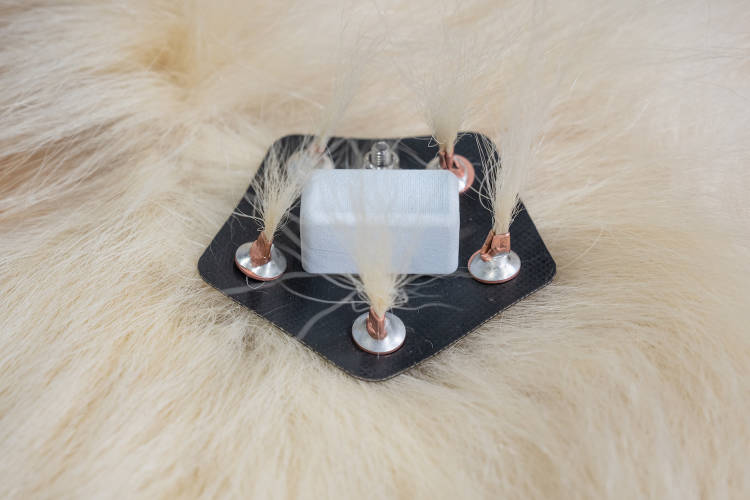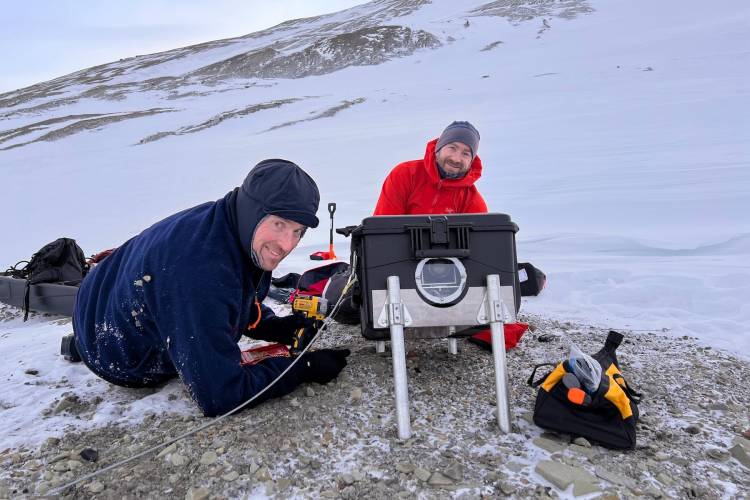Do polar bears follow sleep-wake and other activity patterns like people do, even in the dark of the polar night and 24 hours of sunlight? Until recently, this question was surprisingly difficult for scientists to answer.
Polar bears prefer to spend their time on the Arctic sea ice, hunting for seals. There are, in fact, probably still polar bears that have never set foot on land! Because the Arctic sea ice covers a vast area that is mostly quite inaccessible to humans, we have little thoroughly documented information on the finer details of the bears’ everyday lives out there. What little data we have mostly stems from unique and often single observations witnessed and shared by local indigenous peoples, researchers, and tour guides. These fortunate observations have given us descriptions of diving behavior, hunting strategies, breeding rituals, sleep patterns, and many other fascinating aspects of polar bear behavior.
Satellite collars currently represent the only way for researchers to collect reliable, long-term behavioral data on polar bears: in the beginning, the collars collected only movement data, transmitted as GPS positions as the bears roamed the ice. However, these days, polar bear satellite collars are frequently being used to collect not only data on where and when the bears are moving, but also on frequency of swims, dive depths, ambient temperatures, and even daily activity patterns through POV videos. Still, however, we did not have a good answer to one of the big questions out there: how do the extreme dark/light conditions of the polar night and the midnight sun affect polar bear behavior?
A new study on daily and seasonal behavioral patterns
Enter a recently published scientific paper by Dr. Jasmine V. Ware (Washington State University) and colleagues. The study covers an 8-year period, includes 122* female polar bears from the Chukchi and Southern Beaufort Seas, and is built on data collected via GPS satellite collars that were also fitted with accelerometers (small instruments that measure smaller scale changes in movement). The resulting data allowed the researchers to investigate the dynamics of the polar bears’ daily and seasonal pattern over the whole calendar year.
The findings are not only new, but also intriguing. First, it appears that polar bears, like humans and many other organisms, do indeed possess an inherent circadian (daily) rhythm that spans roughly 24 hours. Researchers often consider daylight one of the primary variables that control such daily rhythms, but in the majority of these bears the length of day only had a slight influence: the duration of their daily rhythm was 24.4 hours during constant daylight (June-August) and 23.9 hours during constant darkness (November-January). The number of active hours (on average, 11) in a day were also largely unchanged throughout the year. It’s important to understand though, that these are average values—in reality, the rhythmicity and activity was characterized by high variability within each bear as well as between bears.
Ringed seal pupping season shakes things up
The time of peak activity during the day also stayed constant in the bears throughout most of the year, centering around the time of noon to 2 p.m. This pattern, however, changed radically during the ringed seal pupping season, where activity was generally spread out evenly over all 24 hours of the day. Ringed seal pupping season (April-June) is an incredibly important time for polar bears. Although polar bears are active hunters year-round, the seal pups represent a relatively easy and high-calorie meal that can be picked off by a bear crashing through the roof of the seal birth lair or sneaking up on young seals basking on the sea ice. Springtime is when polar bears pack on the pounds that keep them round and healthy throughout the often-leaner summer months.
The advantage of being flexible
The results of the study are fascinating. Although we still do not yet know the physiological mechanism behind it, the data show that polar bears retain their daily rhythms over the course of the year, while also maintaining a high degree of what is known as behavioral plasticity (the ability to adjust behavior to the current situation). While neither of these traits are unique to polar bears, it does speak to how well adapted they are at eking out a living in the constantly changing and often harsh environment of the High Arctic sea ice.
* Of these 122 bears, 29 were noted as denning. Denning bears and moms with cubs differed from the other female polar bear in this study in several ways. For example, females with cubs born that same year (cubs of the year) changed their peak activity time to later in the day than other bears.
Link to paper: The Clock Keeps Ticking: Circadian Rhythms of Free-Ranging Polar Bears.
















